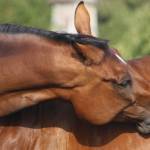Feeding Recommendations for a Healthy Equine Digestive Tract

The following are important tips on proper feeding management that can help the horse maintain a healthy digestive tract.
- Although horses were not designed to eat large meals of grain, they are well equipped to handle large amounts of forage. The diet should be based around forage fed at a rate of at least 1% of the horse’s body weight per day. For example, a 1000-lb (450-kg) horse would need a minimum of 10 lb (4.5 kg) of dry forage (equates to 11 lb of hay or 33 lb of grass) to maintain adequate fiber intake for proper functioning of the digestive tract.
- Maintaining a hindgut full of fiber will aid in regulating temperature. The fermentation of fiber will help to keep the horse warm in the winter. The fiber in the hindgut will also act as a storehouse of water and electrolytes for the horse.
- Small, frequent grain meals will decrease feeding-related problems by eliminating drastic changes in the microbial balance of the digestive tract.
- Within reason, regularity in time and amount of feeding is important.
- Quality of ingredients in the diet is important. Good-quality hay and pasture allow the horse to get optimal nutrition with less indigestible fill. Be sure that grains are processed for maximal digestion in the small intestine, which will result in improved nutrient utilization.
- Keep the amount of grain and fat added to the diet at the minimum necessary to maintain body weight and energy level of the horse. Ideally, no more than 1% of the horse’s body weight should be fed as grain. Reducing anything that may affect the vitality of the microbial population in the hindgut is healthier for the horse.
- The horse’s diet should include adequate amounts of all of nutrients (water, protein, carbohydrates, fat, vitamins, and minerals), which will supply all of the substrates needed for proper feed utilization.
- Eliminate the possibility of bad feed. Buy from a reputable feed manufacturer, and buy only the amount that can be used up in a short amount of time (preferably less than two weeks). Proper feed storage is crucial to the prevention of mold, rancidity, and loss of feed quality that may affect the health of the horse.
- Encourage adequate exercise. Mobility in the horse will encourage motility of the gut. Because the horse evolved nibbling and moving while eating, this exercise pattern is actually the best for integrity of the horse’s digestive tract.
- Proper dental care and routine deworming will give the horse a better chance at getting the most out of the food ingested. Starting with a healthy, parasite-free horse aids in allowing maximum feed utilization and decreased feed usage.
Realization of how important feeding management can be for the health and vitality of the horse is the first step to improving overall performance.








